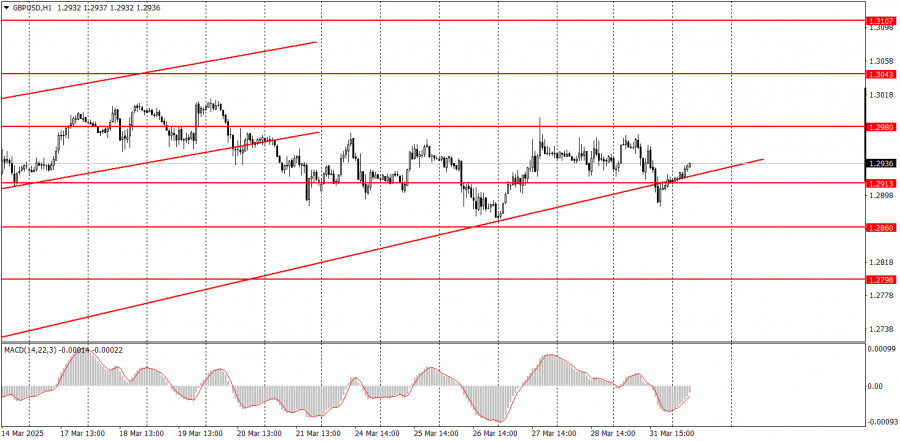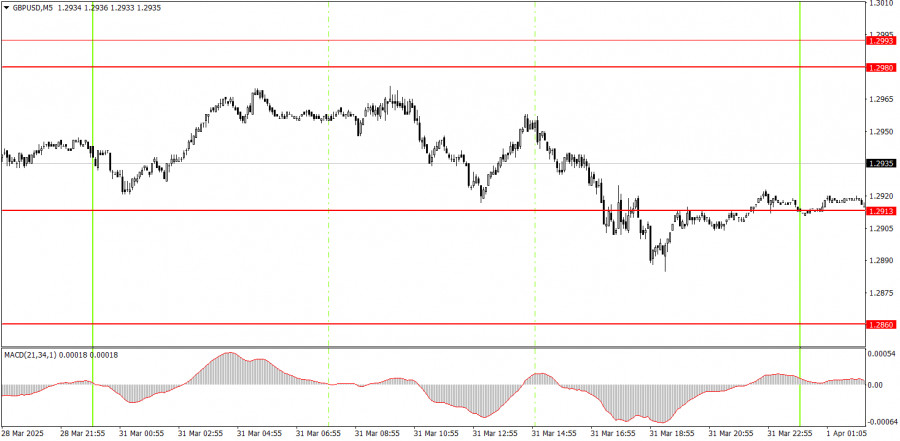Analysis of Tuesday's Trades
1H Chart of GBP/USD
On Tuesday, the GBP/USD pair continued trading within a flat range, just as it has for several weeks. The macroeconomic background of the UK and the U.S. had virtually no impact on the pair's intraday movement. Volatility remains quite low, and the price isn't even testing the boundaries of the sideways channel. As we warned at the beginning of the week, a strong macro or fundamental backdrop does not guarantee the end of a flat phase or the emergence of a solid trend.
For example, yesterday's UK Manufacturing PMI came in weak—but so did the U.S. ISM Manufacturing Index and the JOLTS report. So, in theory, the pound could have declined in the first half of the day and the dollar in the second half. In reality, we didn't see clean or logical movements, and yesterday's reports couldn't pull the pair out of its sideways range. As for Donald Trump, there have still been no updates regarding tariffs.
5M Chart of GBP/USD
In the 5-minute timeframe, quite a few signals formed near the 1.2913 level on Tuesday, but the movements were random, chaotic, and flat—as we've repeatedly warned recently. The 1.2913 level was practically ignored throughout the day and lies nearly at the center of the sideways channel. And within a flat range, it's generally best to trade bounces from the edges, not the midpoint.
Trading Strategy for Wednesday:
In the 1-hour timeframe, GBP/USD should have already started a downtrend, but Trump continues to do everything possible to prevent that from happening. We still expect the pound to fall toward the 1.1800 target in the medium term. However, no one knows how long the dollar's decline driven by "Trump risk" will last. Once this movement ends, the technical picture across all timeframes could change dramatically. For now, long-term trends still point south.
On Wednesday, the GBP/USD pair may continue trading flat. Remember that even extremely strong macroeconomic reports and fundamental news do not guarantee strong price movement. So, the pair may again remain within the 1.2860–1.2980 range today.
On the 5-minute timeframe, the current key levels for intraday trading are: 1.2301, 1.2372–1.2387, 1.2445, 1.2502–1.2508, 1.2547, 1.2613, 1.2680–1.2685, 1.2723, 1.2791–1.2798, 1.2848–1.2860, 1.2913, 1.2980–1.2993, 1.3043, 1.3102–1.3107.
No significant events are scheduled in the UK for Wednesday. In the U.S., only the ADP Employment Change report will be released, which isn't particularly impactful since the more critical NonFarm Payrolls will follow it on Friday. However, today, we may finally learn what new tariffs Trump plans to implement—and who he's targeting in the next round of trade battles.
Core Trading System Rules:
- Signal Strength: The shorter the time it takes for a signal to form (a rebound or breakout), the stronger the signal.
- False Signals: If two or more trades near a level result in false signals, subsequent signals from that level should be ignored.
- Flat Markets: In flat conditions, pairs may generate many false signals or none at all. It's better to stop trading at the first signs of a flat market.
- Trading Hours: Open trades between the start of the European session and the middle of the US session, then manually close all trades.
- MACD Signals: On the hourly timeframe, trade MACD signals only during periods of good volatility and a clear trend confirmed by trendlines or trend channels.
- Close Levels: If two levels are too close (5–20 pips apart), treat them as a support or resistance zone.
- Stop Loss: Set a Stop Loss to breakeven after the price moves 20 pips in the desired direction.
Key Chart Elements:
Support and Resistance Levels: These are target levels for opening or closing positions and can also serve as points for placing Take Profit orders.
Red Lines: Channels or trendlines indicating the current trend and the preferred direction for trading.
MACD Indicator (14,22,3): A histogram and signal line used as a supplementary source of trading signals.
Important Events and Reports: Found in the economic calendar, these can heavily influence price movements. Exercise caution or exit the market during their release to avoid sharp reversals.
Forex trading beginners should remember that not every trade will be profitable. Developing a clear strategy and practicing proper money management are essential for long-term trading success.













